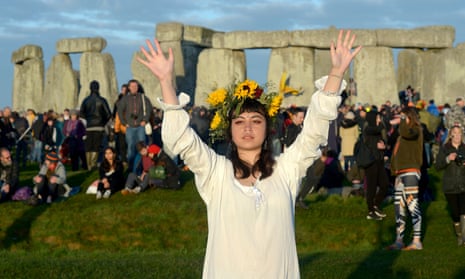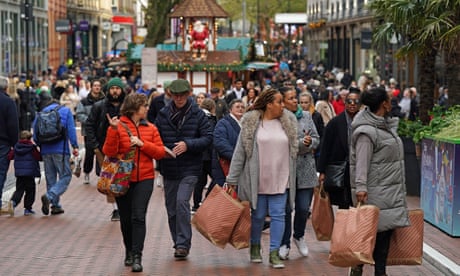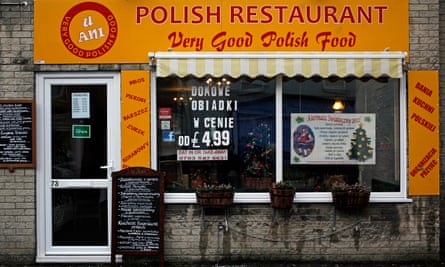Story by Robert Booth, Pamela Duncan and Carmen Aguilar García • Tuesday
THE GUARDIAN
Census results revealing that England is no longer a majority-Christian country have sparked calls for an end to the church’s role in parliament and schools, while Leicester and Birmingham became the first UK cities with “minority majorities”.
For the first time in a census, less than half of the population of England and Wales – 27.5 million people – described themselves as “Christian”, 5.5 million fewer than in 2011. It triggered calls for urgent reform of laws requiring Christian teaching and worship in schools and Church of England bishops to sit in the House of Lords.
Across England and Wales, the Muslim population grew from 2.7 million people in 2011 to 3.9 million in 2021. While 46.2% of people said they were Christian, 37.2% said they had no religion – equivalent to 22 million people. If current trends continue, more people will have no religion than Christianity within a decade.
Many of the biggest falls in Christianity were in parts of the north of England, where only a decade ago seven out of 10 people said they were Christian, but now only half do.
The Office for National Statistics 2021 census data on ethnicity, religion and language published on Tuesday also revealed that:
59.1% of the people of Leicester and 51.4% of the people of Birmingham are now from ethnic minority groups.
81.7% of the population of England and Wales is now white, including non-British, down from 86% in 2011.
The ethnic minority population increased from 14% in 2011 to 18.3%. Of these, 9.3% of the population is Asian British, up from 7.5%, 4% is Black, Black British, Black Welsh, Caribbean-African and African, up from 3.3%, and 5% are from mixed and other ethnicities.
Romanian is the fastest-rising language, with 472,000 people now describing the romance language as their main tongue. Polish is the most common main language aside from English or Welsh.
The fastest-rising religious identity is Shamanism.
The ONS census deputy director, Jon Wroth-Smith, said the figures showed “the increasingly multicultural society we live in”, but added that despite the rising ethnic diversity, “nine in 10 people across England and Wales still identify with a UK national identity, with nearly eight in 10 doing so in London”.
The 10-yearly census results heralded a new era of “super-diversity” in some places. Fourteen local authorities recorded more than half of their usual residents as identifying with an ethnic group other than white, with the highest proportion in the London boroughs of Newham, Brent and Redbridge.
Outside London, the highest non-white proportion was in Slough in Berkshire, followed by Leicester, Luton and Birmingham. One in 10 households in England and Wales now contain people of two or more ethnicities, and across England and Wales, the mixed-race population grew by half a million people to 1.7 million, though the rate of increase was slower than over the previous decade.
The plunging figures for Christianity come after King Charles took on the titles Defender of the Faith and supreme governor of the Church of England upon the death of Queen Elizabeth II. They look likely to pose a challenge to how he frames his monarchy, although he has already said he will serve people “whatever may be your background and beliefs”.
The Archbishop of York, Stephen Cottrell, indicated that the Church knows it faces a struggle to arrest the decline, saying it “throws down a challenge to us, not only to trust that God will build his kingdom on Earth, but also to play our part in making Christ known”.
Lynne Cullens, the Bishop of Barking, insisted the church should not feel “defeated”. “We are like the Nike tick,” she said. “We have to go down before we go up. We will evolve into a church more attuned to the worshipping needs of the communities as they are today.”
But secularists and others now want an end to the Church of England’s position as an established church which requires King Charles to make an oath to preserve the Church of England, guarantees Church of England bishops and archbishops 26 seats in the House of Lords, and means state schools can be required to hold Christian worship.
Vernon Bogdanor, professor of government at King’s College London, said the results make the argument for keeping Church of England leaders in the House of Lords “more difficult to justify” and “raises the issue of the disestablishment of the Church of England”.
“Some will argue that there should not be an established church which represents only a minority of the population,” he said. “Others will respond that the archbishops and bishops seek to represent all faiths, bringing a different perspective to the Lords and that the system works.’”
The National Secular Society’s chief executive, Stephen Evans, said the current status quo was “absurd and unsustainable”, while Prof Linda Woodhead, head of the department of theology and religious studies at King’s College London, said: “The fact that Christianity is no longer the majority religion means policy is out of step with society.”
Dr Scot Peterson, scholar of religion and the state at Corpus Christi College, Oxford, said: “It’s been difficult to defend having an established church since the beginning of the 20th century, but it now becoming a figment of the imagination. The king being the head of the Church of England made sense in 1650, but not in 2022.”
The places with the highest proportion of people saying they had no religion were Caerphilly, Blaenau Gwent and Rhondda Cynon Taf, all in south Wales, and Brighton and Hove and Norwich in England. They were among 11 areas where more than half the population are not religious, including Bristol, Hastings in East Sussex and Ashfield in Nottinghamshire, most of which had relatively low ethnic-minority populations.
The places with the lowest number of non-believers were Harrow, Redbridge and Slough, where close to two-thirds of the populations are from minority ethnic backgrounds.
Census results revealing that England is no longer a majority-Christian country have sparked calls for an end to the church’s role in parliament and schools, while Leicester and Birmingham became the first UK cities with “minority majorities”.
For the first time in a census, less than half of the population of England and Wales – 27.5 million people – described themselves as “Christian”, 5.5 million fewer than in 2011. It triggered calls for urgent reform of laws requiring Christian teaching and worship in schools and Church of England bishops to sit in the House of Lords.
Across England and Wales, the Muslim population grew from 2.7 million people in 2011 to 3.9 million in 2021. While 46.2% of people said they were Christian, 37.2% said they had no religion – equivalent to 22 million people. If current trends continue, more people will have no religion than Christianity within a decade.
Many of the biggest falls in Christianity were in parts of the north of England, where only a decade ago seven out of 10 people said they were Christian, but now only half do.
The Office for National Statistics 2021 census data on ethnicity, religion and language published on Tuesday also revealed that:
59.1% of the people of Leicester and 51.4% of the people of Birmingham are now from ethnic minority groups.
81.7% of the population of England and Wales is now white, including non-British, down from 86% in 2011.
The ethnic minority population increased from 14% in 2011 to 18.3%. Of these, 9.3% of the population is Asian British, up from 7.5%, 4% is Black, Black British, Black Welsh, Caribbean-African and African, up from 3.3%, and 5% are from mixed and other ethnicities.
Romanian is the fastest-rising language, with 472,000 people now describing the romance language as their main tongue. Polish is the most common main language aside from English or Welsh.
The fastest-rising religious identity is Shamanism.
The ONS census deputy director, Jon Wroth-Smith, said the figures showed “the increasingly multicultural society we live in”, but added that despite the rising ethnic diversity, “nine in 10 people across England and Wales still identify with a UK national identity, with nearly eight in 10 doing so in London”.
The 10-yearly census results heralded a new era of “super-diversity” in some places. Fourteen local authorities recorded more than half of their usual residents as identifying with an ethnic group other than white, with the highest proportion in the London boroughs of Newham, Brent and Redbridge.
Outside London, the highest non-white proportion was in Slough in Berkshire, followed by Leicester, Luton and Birmingham. One in 10 households in England and Wales now contain people of two or more ethnicities, and across England and Wales, the mixed-race population grew by half a million people to 1.7 million, though the rate of increase was slower than over the previous decade.
The plunging figures for Christianity come after King Charles took on the titles Defender of the Faith and supreme governor of the Church of England upon the death of Queen Elizabeth II. They look likely to pose a challenge to how he frames his monarchy, although he has already said he will serve people “whatever may be your background and beliefs”.
The Archbishop of York, Stephen Cottrell, indicated that the Church knows it faces a struggle to arrest the decline, saying it “throws down a challenge to us, not only to trust that God will build his kingdom on Earth, but also to play our part in making Christ known”.
Lynne Cullens, the Bishop of Barking, insisted the church should not feel “defeated”. “We are like the Nike tick,” she said. “We have to go down before we go up. We will evolve into a church more attuned to the worshipping needs of the communities as they are today.”
But secularists and others now want an end to the Church of England’s position as an established church which requires King Charles to make an oath to preserve the Church of England, guarantees Church of England bishops and archbishops 26 seats in the House of Lords, and means state schools can be required to hold Christian worship.
Vernon Bogdanor, professor of government at King’s College London, said the results make the argument for keeping Church of England leaders in the House of Lords “more difficult to justify” and “raises the issue of the disestablishment of the Church of England”.
“Some will argue that there should not be an established church which represents only a minority of the population,” he said. “Others will respond that the archbishops and bishops seek to represent all faiths, bringing a different perspective to the Lords and that the system works.’”
The National Secular Society’s chief executive, Stephen Evans, said the current status quo was “absurd and unsustainable”, while Prof Linda Woodhead, head of the department of theology and religious studies at King’s College London, said: “The fact that Christianity is no longer the majority religion means policy is out of step with society.”
Dr Scot Peterson, scholar of religion and the state at Corpus Christi College, Oxford, said: “It’s been difficult to defend having an established church since the beginning of the 20th century, but it now becoming a figment of the imagination. The king being the head of the Church of England made sense in 1650, but not in 2022.”
The places with the highest proportion of people saying they had no religion were Caerphilly, Blaenau Gwent and Rhondda Cynon Taf, all in south Wales, and Brighton and Hove and Norwich in England. They were among 11 areas where more than half the population are not religious, including Bristol, Hastings in East Sussex and Ashfield in Nottinghamshire, most of which had relatively low ethnic-minority populations.
The places with the lowest number of non-believers were Harrow, Redbridge and Slough, where close to two-thirds of the populations are from minority ethnic backgrounds.
Shamanism, pagans and wiccans: trends from the England and Wales census
There are more pagans, fewer French speakers and 2.5 million households are of more than one ethnic group

People celebrating the summer solstice, a pagan festival day, at Stonehenge in 2019.
Photograph: Martin Dalton/Rex/Shutterstock
Robert Booth, Carmen Aguilar García and Pamela Duncan
Robert Booth, Carmen Aguilar García and Pamela Duncan
Tue 29 Nov 2022 THE GUARDIAN
1) Shamanism is on the rise
Shamanism is expanding faster than any other religion, with the number of people saying they practise it rising from 650 in 2011 to 8,000 in 2021 in England and Wales. The result might prove controversial, as the Shamanism UK website asserts “it is not a religion, more an authentic expression of mankind’s spirituality”.
2) Pagans and wiccans are becoming more established

England and Wales now minority Christian countries, census reveals
More established are pagans, who number 74,000 people (up from 57,000 in 2011) and who gather most in Ceredigion, Cornwall and Somerset, and wiccans, who number 13,000. Wicca is sometimes described as a witchcraft tradition whose roots lie in pre-Christian religious traditions, folklore, folk witchcraft and ritual magic.
1) Shamanism is on the rise
Shamanism is expanding faster than any other religion, with the number of people saying they practise it rising from 650 in 2011 to 8,000 in 2021 in England and Wales. The result might prove controversial, as the Shamanism UK website asserts “it is not a religion, more an authentic expression of mankind’s spirituality”.
2) Pagans and wiccans are becoming more established

England and Wales now minority Christian countries, census reveals
More established are pagans, who number 74,000 people (up from 57,000 in 2011) and who gather most in Ceredigion, Cornwall and Somerset, and wiccans, who number 13,000. Wicca is sometimes described as a witchcraft tradition whose roots lie in pre-Christian religious traditions, folklore, folk witchcraft and ritual magic.
3) Romanian is the fastest growing language
“Bine ati venit!” Welcome to the fastest growing language in England and Wales: Romanian. 472,000 people now describe the romance language as their main tongue – up from 68,000 in 2011. The centre of the Romanian-speaking population is Harrow in north-west London.
4) There are more mixed ethnicity households
The census recorded that 2.5 million households consisted of members identifying with two or more different ethnic groups – an increase of half a million on 2011. Among individuals identifying as mixed ethnicity the largest increase was among those identifying as “other mixed or multiple ethnic groups” rather than white and black, or white and Asian.
5) Cornish people are feeling more Cornish
In Cornwall 14% of the population (80,000 people) selected only a “Cornish” identity – an increase from 9.9%, or 53,000, in 2011.
6) There are fewer French, Gujarati and Bengali speakers
Languages you are less likely to hear as someone’s main tongue in England and Wales are French, reflecting a fall in the number of people identifying their nationality as French (down from 147,000 to 120,000), and Gujarati and Bengali, perhaps suggesting successive generations after earlier migrations from south Asia are speaking those languages less.
7) Polish is most widely spoken after English and Welsh
On the rise, though, is Polish, now the most popular main language after English and Welsh. To have the best chance of hearing it, head to Boston in Lincolnshire, a hotbed of Brexit support in the 2016 referendum, where 5.7% of the population – about 4,000 people – speak Polish as their main language.

The Polish restaurant in Boston, Lincolnshire.
Photograph: David Sillitoe/The Guardian
8) Manx Gaelic speakers are in single figures
The rarest language in England and Wales is Manx Gaelic, which is spoken as a main language by just eight people, followed by Ulster Scots (16) and Irish Traveller Cant (36). Those worrying about the demise of Cornish can rest a little easier: 10 more people said it was their main language than in 2011 (567 people in 2021) and Yiddish has undergone a mini-revival, up from fewer than 4,000 speakers as a main language to 5,356 over the decade.
9) There was a small rise in numbers of Buddhists
Despite the growth in mindfulness meditation practice over the last decade, the number of people following Buddhism, from which the practice derives, saw just a modest increase of 0.1 percentage points, from 249,000 to 273,000 people identifying as such in England and Wales. The highest concentration of Buddhists was again found in Rushmoor in Hampshire – home to the Aldershot Buddhist Community Centre – where the census counted 4,732, up from 3,092 a decade ago.
10) There are more British Sign Language users
British Sign Language (BSL) was the main language of 22,000 people – an increase of over 6,000 since 2011. The hotspot is Derby, with 400 users, and much of this is likely to be down to the location of the Royal School of the Deaf.
No comments:
Post a Comment